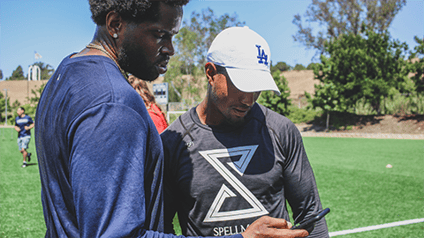Sharing Data with Your Athletes
What data is worth sharing with your athletes?

Keep it Simple
When reporting back to athletes, there’s tons of data points and information. It's important to remember that from the athlete’s perspective, the data you give them is only as good as their understanding.
We’ve discussed the idea of over communicating before, which you can read more on here.
Basically, you'll want to find the 1-2 metrics that influence the other metrics.
For example, you're not going to show an athlete all the mistakes they’re making at max velocity if they haven’t figured out the initial acceleration phase.
If in their first phase they’re only hitting a fraction of their velocity, it’s probably more important to focus on the beginning part before touching on the later parts of the run.
Key takeaway #1 is to only give athletes 1-2 things at a time to focus on.
Looking at Force Velocity Numbers
One of the simplest ways to think about improving an athlete’s speed is by improving power. We explain that equation in more depth in this article here.
But in terms of data, if you're looking at force velocity numbers, you can see two things:
- An athletes peak ability to produce force and acceleration
- Their peak ability to produce velocity.
From there, ask if one of those sides are underdeveloped. Or are they both underdeveloped? Which needs to be attacked first?
When prioritizing, the majority of developing athletes need help on the acceleration front.
They need to develop more horizontal force.
When looking at some of the fancy data, contact times, air times, etc. a lot of it will be resolved from resisted running and drills.
To increase the ability to produce force, there's a physiological adaptation needed from resisting running, sleds, hills, etc.
There’s also a technical adaptation. Cues of projecting the body out, attacking back, hitting the ground. Spend time working on that.
So the contact times and velocity metrics are showing what you're doing is working. Or, they’re showing what you're doing is not working, which is when you need to make an adjustment.
Taking your intuition -> putting it into a number -> then influencing your programming on what your seeing change.
If you see numbers go up, there’s an adjustment you need to make. If you see numbers go down, you pat yourself on the back and keep doing what you're doing.
This isn’t to say you should set it and forget it. This is why we preach the importance of consistent testing!
Continue to monitor so that you’re constantly aware of what tweaks need to be made to keep the improvement.
Use the number to dictate what you already know. Use your intuition as a coach to figure out what metric is severely lacking and go towards that. For the metric that’s doing extremely well, maintain that.
If you affect the force and decrease the velocity you have an issue. It’s Important to keep both qualities going at the same time.
Want help figuring out what data to use and how to apply it? Check out our course, How to Build a Speed Training System to learn how to get started.